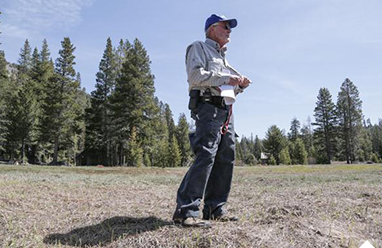Every winter, the California Department of Water Resources offers the public a little piece of what you might call outdoors theater. Once a month, the department sends a crew to a picturesque spot near Echo Summit, near U.S. 50 high above Lake Tahoe. The crew measures the snow, then tells reporters how much there is. Then the reporters tell the rest of us the news.
More snow is good, because it will melt when the weather warms up, then run down streams and rivers into the state's reservoirs. More water is good because that means there's enough for the farms that use about 80 percent of California water, and there's enough for the rest of us to water our lawns, wash our cars, and just run the tap without thinking a whole lot about it. There's even enough water in good years to let nature have some.
You might have heard that this is not one of those good years. Thursday, the Department of Water Resources gave us a reading on how not-good this year really is.
Here's how Doug Carlson, an information officer at the department, put it when he spoke to KQED Science intern Shara Tonn on Thursday: "This is the final snow survey of the year today. Didn't find much snow at all."
Human surveyors, who these days do little more than replicate what electronic sensors throughout the Sierra are recording every hour of every day during the snow season, found a snowless meadow when they visited a traditional measurement site near Echo Summit. The DWR reported that the physical measurements combined with electronic monitoring determined that the water content of snow throughout the Sierra Nevada is just 18 percent of average for May 1. In the northern Sierra, where melting snow is counted on to help fill the state's biggest reservoirs, the report is more dire: the water content of the snowpack there is just 7 percent of average.

